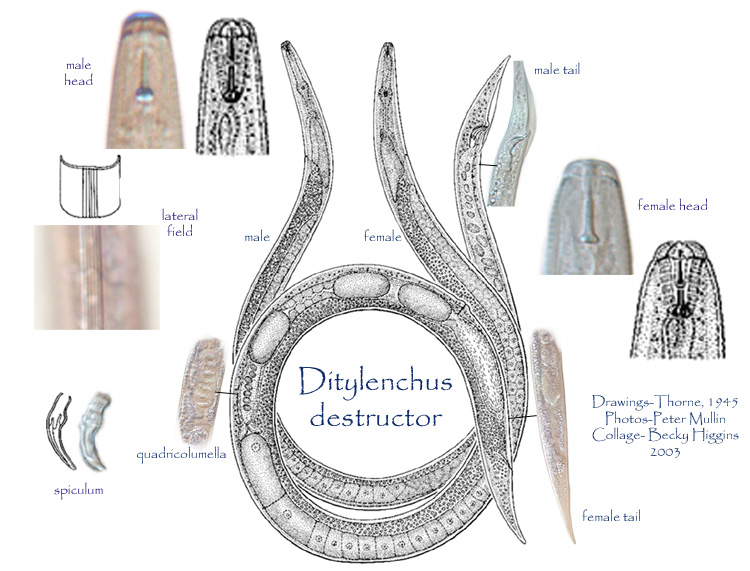Thorne, 1945


|
|
Cuticle near head marked by transverse striae about 1 u apart,
while on the remainder of the body the striae are obscure unless the specimens
are shrunken by cold fixative. Lateral fields with six incisures,
which are reduced to two on the neck and tail. Deirids usually visible
near base of neck. Hemizonid slightly anterior to excretory pore.
Phasmids not observed. Cephalic papillae and amphids visible only
from a face view, arranged in a manner similar to those figured for Ditylenchus
disaci. Labial framework well sclerotized. Spear typical
of the genus, with rounded knobs. Basal bulb of esophagus with three
large and two small gland nuclei, generally extended in a lobe reaching
back over the dorsal side of the intestine. This lobe may be either
shorter or longer than that
illustrated. Anterior end of intestine extending into base of
esophagus, where it connects with the lumen by an obscure valvular apparatus.
Intestine densely granular, ending in a distinct rectum and anus.
Anterior ovary outstretched to near base of
esophagus, the developing oocytes often arranged in two lines, changing
to tandem near the middle of the ovary. Eggs average slightly longer
than body diameter and are about one-half as wide as long. Posterior
uterine branch rudimentary, not observed to function as a spermatheca.
Spermatozoa usually well up in the uterus. Lips of vulva thick, elevated.
Vulva-anus distance 1 3/4 to 2 1/2 times tail length.
Testis outstretched to near base of esophagus
with spermatogonia arranged mostly in single line until near the middle
of the body, where they become primary spermatocytes from which the spermatozoa
are produced. Spicula with a distinctive sclerotized pattern as
illustrated. Bursa extending from a point about opposite the
proximal ends of the spicula to about two-thirds the tail length.
Lateral incisures usually reduced to four near the tail, forming a pattern
similar to that figured for Ditylenchus
dipsaci.
Type host: Solanum tuberosum, potato
Type locality: Fields near Aberdeen, Idaho
(Description- Thorne, 1961)
DNA Sequences Obtained
| Specimen: | Collected: |
| DdDH 1 | In culture |
| DdDH 5 | In culture |
| Fleish 1 | In culture |
| Fleish 4 | In culture |
 |
 |
 |